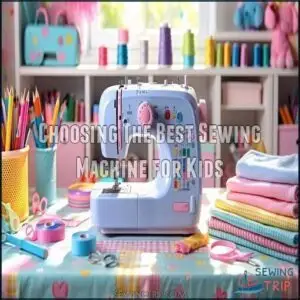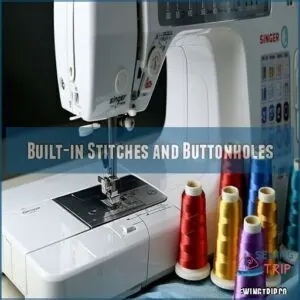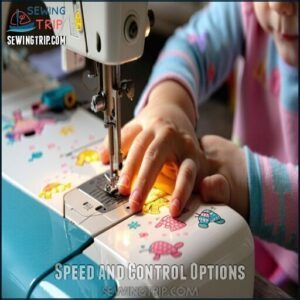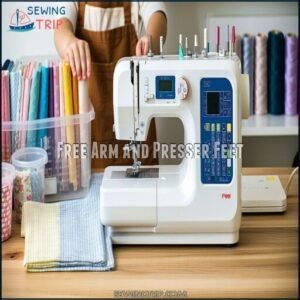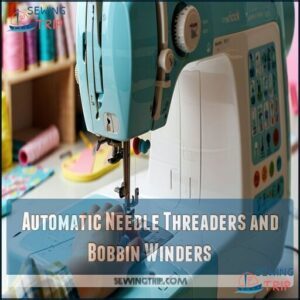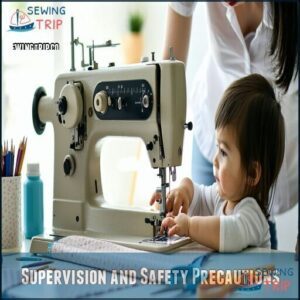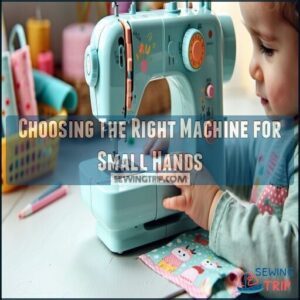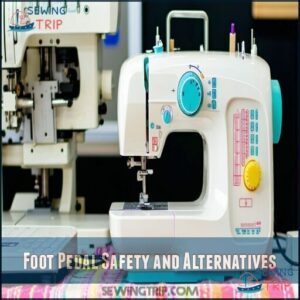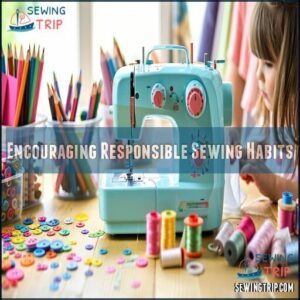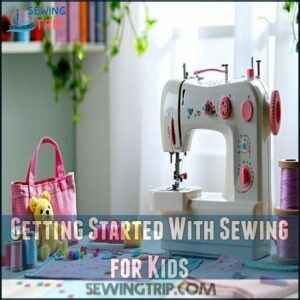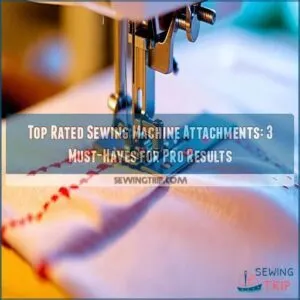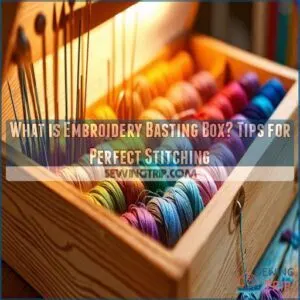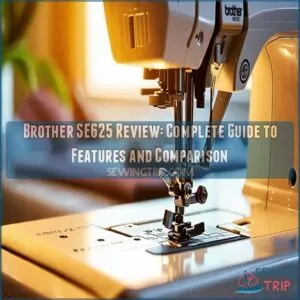This site is supported by our readers. We may earn a commission, at no cost to you, if you purchase through links.
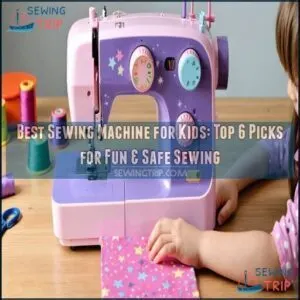 You’ll find the best sewing machine for kids strikes the perfect balance between safety and functionality.
You’ll find the best sewing machine for kids strikes the perfect balance between safety and functionality.
Look for models with finger guards, lower speeds, and simple stitch selections like the Janome Fastlane or Brother XM1010.
Kids’ machines should have clear threading paths and stability—nothing worse than chasing a runaway machine across the table!
Choose one with adjustable speed control so your budding designer can start slow and build confidence.
The right machine grows with your child from simple straight stitches to more creative projects, and safety features matter, but don’t underestimate the power of a machine that comes in their favorite color!
Table Of Contents
Key Takeaways
- You’ll want to prioritize safety features like finger guards, lower speeds, and automatic needle threaders to protect small hands while they learn to sew.
- Choose machines with simple interfaces and limited stitch options (10-12 built-in stitches) that won’t overwhelm beginners but still allow room for growth as their skills develop.
- Consider size and weight—look for lightweight models (under 10 pounds) with ergonomic designs that small hands can manage comfortably while maintaining stability.
- Don’t underestimate the importance of proper setup—create a dedicated workspace with good lighting, organize supplies in labeled containers, and ensure the machine sits on a stable surface at the right height for your child.
Choosing The Best Sewing Machine for Kids
Choosing the right sewing machine for your child means balancing safety, ease of use, and features that match their skill level.
It’s like finding the perfect pair of shoes—comfortable, reliable, and built to grow with them.
Essential Considerations for Age and Ability Level
Choosing the right sewing machine for kids depends on age groups, skill levels, and learning pace. A kid-friendly sewing machine guarantees safety and boosts confidence.
- For ages 6-8, pick basic models with finger guards and slow-speed options.
- Tweens can handle machines with extra stitches and speed adjustments.
- Lightweight designs (under 10 pounds) suit small hands for easy handling.
- Machines with jam-resistant bobbins and simple threading reduce frustration.
The right kids sewing machine grows with your child, making sewing fun and frustration-free!
Important Safety Features to Look For
Safety is the name of the game when picking a kid-friendly sewing machine.
Beyond fun designs and features, prioritize sewing machine safety to protect little hands. Accidents can happen, but the right safety features keep them rare.
Look for these must-haves:
- Finger guards and needle covers to prevent tiny fingers from straying into danger zones.
- Automatic threaders that let kids skip the tricky threading process altogether.
- Jam-resistant bobbins to cut down on frustration and reduce risks.
- Speed control to help beginners sew at a safe, manageable pace.
Machines with safety locks and emergency stop buttons add peace of mind. Still, no safety feature beats your supervision—because even the best gadgets can’t replace a watchful eye.
Ease of Use and Simplicity
An easy sewing machine can make learning enjoyable instead of frustrating.
The best kid friendly sewing machines include simple controls and an intuitive design—like brightly marked buttons or color-coded threading paths—to keep things stress-free.
Beginner modes and basic functions help kids stay focused without distractions.
A user interface that’s clear and straightforward guarantees young sewists spend more time creating and less time troubleshooting.
Look for portable sewing machines with quick setup options, so your kids can start sewing in minutes.
Considering the compact size options is essential for easy handling by children.
The right balance of simplicity and functionality turns a beginner sewing machine into a fantastic tool for creative growth, making it an enjoyable experience for kids to learn and sew.
Benefits of Sewing for Kids
Sewing isn’t just a hobby—it’s a superpower for kids that teaches them life skills while sparking creativity.
With the right kids sewing machine, you’re planting seeds for their growth and independence.
Creating something from scratch gives kids a sense of creative freedom and pride.
It’s more than threading needles—it’s about threading confidence into their world.
Here’s how sewing for kids makes a difference:
- Creative Expression: Turning ideas into real projects boosts their imagination and originality.
- Fine Motor Skills: Guiding fabric and handling tools improves coordination and focus.
- Problem Solving: Reading patterns and fixing mistakes sharpens their thinking.
- Patience Building: Watch as their steady work ethic unfolds one stitch at a time.
A skill sewn for life!
What Makes a Good Sewing Machine for Kids
You’ll need to find a sewing machine that combines safety features like finger guards and adjustable speed controls with kid-friendly design elements that won’t frustrate small hands.
The perfect children’s sewing machine strikes that delicate balance between being simple enough for beginners yet versatile enough to grow with your child’s developing skills.
Built-in Stitches and Buttonholes
After finding the perfect machine size and safety features for your little one, you’ll want to think about what stitches they’ll need to start their sewing journey.
Built-in stitches can make or break your child’s sewing experience. Most kids don’t need complicated options – a good starter machine offers 10-12 basic stitch functions that grow with their skills.
The Janome 2212 and C30 models include essential buttonhole stitches that’ll come in handy as your child advances to clothing projects. Learning different stitch techniques will expand their sewing capabilities.
Look for machines that feature:
- Straight and zigzag stitches for basic construction
- Simple decorative stitches to spark creativity
- Adjustable stitch length for different fabrics
- Reverse stitch capability for reinforcement
While one-step buttonholes are easier than four-step versions for small hands, they aren’t necessary for beginners. Remember, stitch variety should match your child’s age – too many options can overwhelm, while too few might limit their creative growth.
Speed and Control Options
The right speed control options can transform your child’s sewing journey from frustrating to fantastic.
When selecting a sewing machine for kids, prioritize models with:
- Sliding speed controls that allow beginners to start slow and gradually increase as confidence builds
- Start/stop buttons positioned away from tiny fingers, offering a safer alternative to traditional foot pedals
- Variable speed settings with intuitive markings like turtle/rabbit icons for easy understanding
These features prevent fabric rushing and reduce accidents while building confidence.
Many parents tell me their children stick with sewing longer when they can control the pace themselves.
Consider also the machine’s speed capabilities for ideal performance.
Look for speed settings that feel responsive yet forgiving for small hands.
Free Arm and Presser Feet
Free arm features and presser foot options can transform your child’s sewing journey from basic to brilliant.
A free arm creates a narrow sewing platform that’s perfect when your kids tackle tubular projects.
This clever design allows children to easily:
- Hem pants without struggling
- Navigate small sleeve openings
- Create doll clothes with proper seam allowances
Most kids’ sewing machines include free arms proportioned for smaller hands, ensuring comfort during fabric feeding.
Presser feet are equally important for expanding creativity.
Standard machines typically come with a general-purpose foot, but look for models offering additional options like zipper feet for closures and buttonhole feet for finishing touches.
Precise stitching is one benefit of using a free arm.
These seemingly small attachments make a big difference in what your young sewist can create.
With the right presser foot types, even beginner quilting options become accessible, helping your child’s skills grow alongside their confidence.
Automatic Needle Threaders and Bobbin Winders
Why watch your child struggle with needle threading when an automatic needle threader can transform frustration into joy? This feature allows small fingers to avoid the precision task that often derails beginners.
Pair it with jam-resistant bobbin systems for truly hassle-free sewing.
Modern machines offer automation accuracy with self-stopping bobbin winding mechanisms that prevent thread tangles. Look for models with color-coded threading paths and clear instructions that simplify setup.
These smart sewing machine features let kids focus on creating rather than troubleshooting—the difference between abandoning the hobby and developing a lifelong skill.
Regular threader maintenance guarantees consistent performance for years to come.
Top 6 Sewing Machines for Kids
You’ll find the perfect starter machine for your young crafter in our carefully tested selection, featuring models with kid-friendly safety features like finger guards and speed controls.
After rigorous testing on various fabrics and consulting with sewing experts, we’ve narrowed down the options to these six machines that balance ease of use, safety, and enough features to grow with your child’s developing skills.
1. Janome Fastlane Fuschia Sewing Machine
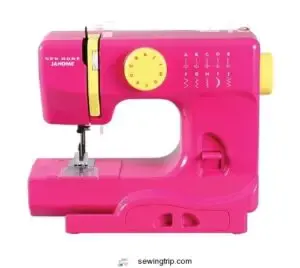
The Janome Fastlane Fuschia sewing machine packs a powerful punch for young creators, despite its lightweight 5-pound design.
You’ll find it incredibly portable for sewing classes or small workspaces.
With 10 built-in stitches and a free arm feature, it’s perfect for beginners tackling simple projects like doll clothes or basic alterations.
Parents will appreciate the finger guard on the presser foot that keeps little hands safe.
While it runs a bit louder than premium models, this machine handles light to medium fabrics beautifully, making it an excellent starter option for crafts and beginner clothing projects, and is a great choice for young creators.
Best For: Beginners, young creators, or anyone needing a lightweight and portable sewing machine for simple projects.
- Lightweight and compact, perfect for travel or small spaces.
- Includes 10 built-in stitches with an easy reverse function.
- Safety-focused design with a finger guard on the presser foot.
- Limited advanced features and no buttonhole stitches.
- Smaller needle area, which may feel restrictive.
- May require adult supervision for younger users.
2. Brother XM1010 Sewing Machine 10 Stitches
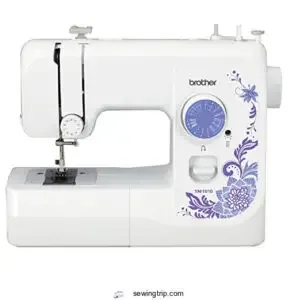
Your child will love the Brother XM1010, a perfect stepping stone for budding sewists.
With 10 built-in stitches including decorative options and an auto-size buttonhole, it offers variety without confusion. Kids appreciate the jam-resistant bobbin system and easy stitch selection that builds independence.
Its lightweight design with built-in handle means easy setup anywhere. The machine comes complete with four sewing feet, needles, bobbins, and a bilingual manual.
The free arm feature handles sleeves and cuffs, while the 25-year warranty guarantees this reliable choice grows with your child.
Best For: Beginner sewists or children learning basic sewing skills.
- Lightweight and portable with a comfortable handle for easy transport.
- Features 10 built-in stitches, including auto-size buttonhole, for versatile beginner projects.
- Comes with a 25-year limited warranty for long-term reliability.
- Limited to 10 stitches, which may not suit advanced sewing needs.
- Lacks advanced features like adjustable presser foot control.
- Manual upper thread tension adjustment may require practice for new users.
3. Singer Simple Sewing Machine
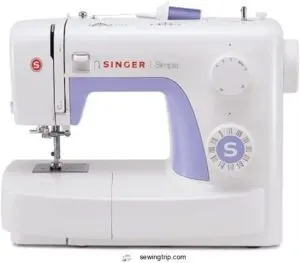
While many kid-friendly machines feel like toys, the Singer Simple 3232 delivers real sewing capability at a beginner-friendly level.
It features 32 built-in stitches and an automatic needle threader that makes setup frustration-free.
The heavy-duty metal frame keeps the machine steady during enthusiastic projects, while adjustable stitch settings grow with your child’s skills.
The machine also offers automatic needle threading for added convenience.
With a manageable 750 stitches-per-minute top speed and included specialty feet (buttonhole, zipper), this machine bridges the gap between starter models and adult machines—perfect for kids ready to take their sewing seriously.
Best For: Beginners, including children and teenagers, who want a reliable and easy-to-use sewing machine for learning and basic projects.
- 32 built-in stitches and 1-step automatic buttonhole for versatile sewing options.
- Heavy-duty metal frame ensures stability during use.
- Built-in automatic needle threader simplifies setup.
- Limited to 750 stitches per minute, lower than advanced models.
- No LED lighting, unlike some newer machines.
- Stitch selection adjusted manually via dial, which may feel outdated to some users.
4. Sew Cool Sewing Machine
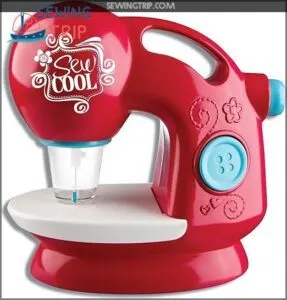
The Sew Cool machine stands out as the most beginner-friendly option since it doesn’t require threading, bobbins, or foot pedals.
Instead, it’s a felting device with six safety-guarded needles that weave felt together. Your 6+ year-old can start creating immediately with the included kit of fabric sheets, pre-cut projects, and decorative elements.
At just 1.66 pounds, it’s perfectly sized for small hands, and the automatic light helps kids see their work clearly. For best results, use regular felt rather than the included fabric to prevent jamming issues, which makes it a great tool for kids to learn and have fun with felting.
Best For: Kids aged 6 and up who want an easy and safe introduction to crafting with felting projects.
- Simple and safe design eliminates the need for threading and bobbins.
- Lightweight and portable, perfect for small hands and easy storage.
- Comes with pre-cut projects and decorations for instant creativity.
- Only works with proprietary Sew Cool fabrics, limiting material options.
- Needles cannot be replaced if broken or dull, affecting longevity.
- Fabric jamming can occur if not carefully used.
5. Michley Lil Mini Sewing Machine
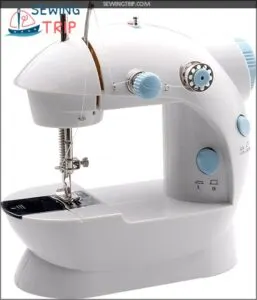
Among our top picks, the Michley Lil Mini stands out as a perfect entry-level machine for budding sewists.
Weighing just 15.5 ounces, it’s incredibly portable for small hands. You’ll love its versatility—operate it with the included foot pedal or convenient hand switch.
The dual power options (batteries or AC adapter) make it ideal for crafting anywhere. Setup is a breeze with the top drop-in bobbin and automatic thread rewind.
While it handles lightweight fabrics beautifully with double thread stitches, it’s not suited for heavy denim. Be prepared for some noise and to help interpret the instructions.
Best For: Beginners or kids looking for a lightweight, portable sewing machine for simple projects on lightweight fabrics.
- Portable and lightweight, easy to carry and store.
- Dual power options (batteries or AC adapter) for convenience.
- Quick and simple setup with top drop-in bobbin and thread rewind.
- Not suitable for heavy fabrics like thick denim.
- A bit noisy during operation.
- Instructions can be hard to understand for some users.
6. Mini Sewing Machine for Kids
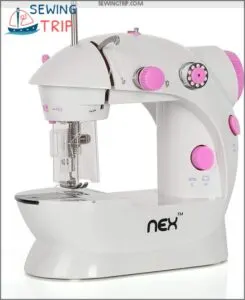
With its palm-sized design, this Mini Sewing Machine delivers real functionality in a child-friendly package.
You’ll love that it runs on either a power adapter or four AA batteries, making it perfect for sewing anywhere from bedrooms to backyards.
The simple on/off button paired with adjustable speed settings allows kids to build confidence gradually.
A protective needle cover keeps little fingers safe while the built-in LED light illuminates their workspace, preventing eye strain during longer projects.
Though it only performs straight stitches, this limitation actually helps beginners master fundamental techniques before tackling complex patterns.
The compact size fits easily in storage spaces and small hands.
Parents should assist with initial threading and tension settings, transforming this from a toy into a genuine learning tool that encourages creativity and practical skills development.
Best For: Parents and beginners looking for a safe, compact sewing tool to inspire creativity and teach practical skills to children.
- Lightweight, portable, and easy to handle.
- Dual power options for versatility.
- Built-in LED light enhances visibility during projects.
- Limited to simple straight stitches.
- Requires adult assistance for threading and setup.
- Not suitable for heavy-duty sewing tasks.
Key Safety Considerations for Kids
You’ll need to protect those little fingers with sewing machines that feature needle guards, finger protectors, and adjustable speed controls for your young creator.
While teaching your child to sew is exciting, choosing a machine with proper safety features will prevent those "oops" moments that can turn crafting time into band-aid time.
Supervision and Safety Precautions
With a child-friendly sewing machine comes great responsibility.
Adult supervision remains essential whenever kids operate sewing equipment to prevent injuries and develop safe practices.
Establish these non-negotiable safety protocols:
- Always unplug the machine when not actively sewing
- Teach proper finger positioning away from needles and moving parts
- Keep the workspace organized and free from distractions
Creating a well-lit, designated sewing area helps children focus while you monitor their progress.
"Safety scissors are called that for a reason," as my grandmother used to say—the same principle applies to kids’ sewing machines.
Emergency procedures should be discussed beforehand so little sewists know exactly what to do if something goes wrong, and this is crucial for preventing injuries and ensuring proper finger positioning is maintained at all times, which is a key part of developing safe habits.
Choosing The Right Machine for Small Hands
While selecting a sewing machine for children, hand size should be your primary consideration for both safety and enjoyment.
The best kids sewing machines feature intuitive interfaces with clearly marked functions, and you’ll want a child-friendly sewing model that’s lightweight enough for small hands to control confidently.
| Feature | Why It Matters | Kid-Friendly Option |
|---|---|---|
| Machine Weight | Prevents fatigue | Under 5 pounds |
| Button Size | Easy operation | Large, colorful controls |
| Ergonomic Design | Reduces strain | Curved grips, finger spaces |
| Motor Power | Manageable speed | Lower power options |
| Portability | Storage flexibility | Compact dimensions |
Rather than struggling with adult-sized equipment, your young crafter will thrive with ergonomically designed tools that match their proportions, and look for finger guards and sturdy construction that won’t tip when they’re creating their masterpieces.
Foot Pedal Safety and Alternatives
For young sewers with small feet, traditional foot pedals can be tricky to manage.
You’ll find several kid-friendly alternatives that make controlling a kids sewing machine much safer and easier.
Here are 5 foot pedal alternatives that enhance safety:
- Start/stop buttons offer precise fingertip control without pedal pressure concerns
- Dual-speed settings let you choose between slow and slower, perfect for beginners
- Hand-crank models provide manual operation at your child’s comfortable pace
- Pedal guards prevent accidental slipping when using traditional foot pedals
- Wireless pedal options allow flexible positioning for better ergonomics
These alternative activation methods remove the frustration of managing pedal size ergonomics, letting children focus on their creative projects rather than struggling with foot pedal coordination.
Encouraging Responsible Sewing Habits
Instilling responsible sewing habits in and around your child’s creative space guarantees both safety and success.
Teaching kids to respect their sewing machine transforms them into confident young crafters who’ll enjoy the hobby for years to come.
Guarantee your child works in a clean workspace with good lighting and ties back long hair.
After each session, guide them through a quick tool organization routine—it’s just as important as the sewing itself.
Remember: consistent material handling habits today become lifelong skills tomorrow.
Age-appropriate supervision gradually decreases as their safety awareness increases.
Getting Started With Sewing for Kids
You’ll set your child up for sewing success with the right workspace and a kid-friendly machine that includes essential safety features like speed control and finger guards.
Once you’ve created a comfortable sewing station, start with simple projects that build confidence while teaching basic techniques—remember, even those crooked first stitches are creating memories and skills that last a lifetime, which is a key part of building confidence.
Setting Up The Machine and Workspace
Now that you’ve prioritized safety, let’s create an ideal workspace where your child’s creativity can flourish.
Setting up a proper sewing area starts with smart machine placement. Position the kids sewing machine on a sturdy, appropriately-sized table where your child sits comfortably with feet touching the floor. Good workspace ergonomics prevent fatigue and improve concentration.
Proper lighting needs can’t be overlooked—set up near natural light and add a desk lamp to eliminate shadows on detailed work.
Organize the workspace with these essentials:
- A clean, stable surface with enough room for fabric handling
- Small containers for supplies like threads, bobbins, and scissors
- A magnetic pin cushion to prevent dropped pins
Manage cords carefully to prevent tripping hazards by securing them away from foot traffic. The right sewing machine setup makes operation smoother and more enjoyable—just like professional tailors have their stations perfectly arranged. Consider a dedicated sewing machine stand for ideal stability.
Remember, a tidy workspace teaches responsibility while making sewing machine accessories easily accessible. This setup promotes a comfortable and enjoyable sewing experience for your child, fostering their creativity and skill development in a well-organized environment.
Choosing Simple Projects and Tutorials
Now that your workspace is set up, let’s find the perfect first project for your child’s sewing journey.
Start with projects that have minimal pieces and quick completion times. Fat quarter bags, pillowcases, and doll skirts are excellent choices for beginners.
Trust your child’s intuition when selecting patterns—sometimes they’ll surprise you with what they can accomplish!
The best kid-friendly tutorials feature step-by-step instructions and offer creative possibilities.
Simple projects build confidence while teaching fundamental skills that lead to more complex creations, which is key to a successful sewing journey and helps develop fundamental skills.
Encouraging Creativity and Experimentation
Once your child masters the basics on their kids sewing machine, it’s time to foster their creative potential.
Encourage experimentation with these simple strategies:
- Create a "treasure box" of fabric scraps in various textures and colors
- Practice decorative stitches on test fabric before applying to real projects
- Set up themed challenges like "create something wearable from old t-shirts"
- Combine unexpected materials (ribbon, buttons, felt) for unique designs
Don’t worry about perfection—the goal is exploration and fun!
Building Confidence and Skills
Now that your child is exploring their creativity, let’s build those skills step by step.
Watch confidence bloom as they master each new technique on their kids sewing machine. Start with simple projects that guarantee success, then gradually increase project complexity.
To further boost their confidence, try praising their efforts rather than focusing on perfection.
Skill Level Project Ideas
Encouragement Tips
————
Beginner
Intermediate
Advanced
Frequently Asked Questions (FAQs)
What is the best sewing machine for kids?
For kids, the Janome Fastlane Fuschia stands out with its finger guard and 10 built-in stitches.
You’ll also love the Singer ZigZag or Michley LSS-202 for their beginner-friendly designs and safety features.
What is the best sewing machine for 8 year old?
For an 8-year-old, you’ll want the Janome Fastlane Fuschia or NEX Portable Mini.
Both feature finger guards, speed controls, and intuitive interfaces that’ll grow with your child’s developing skills and confidence.
What is the best sewing machine for beginners?
With over 22,000 reviews and a 7/5 rating, the Brother CS7000X stands out for beginners.
You’ll love its 70 built-in stitches and beginner-friendly features that make learning to sew feel less like rocket science and more like creative freedom.
How do I choose a sewing machine for kids?
Look for safety features like finger guards and speed controls.
Choose models with lightweight designs, simple controls, and jam-resistant bobbins.
Consider your budget, as good options exist between $30-
Prioritize ease of use.
Are sewing machines safe for children?
Yes, sewing machines can be safe for children with proper supervision and kid-friendly features like needle guards, finger protectors, and adjustable speed controls.
You’ll want to make certain they’re using age-appropriate models with built-in safety features.
Is the Sew Cool sewing machine good for kids?
The Sew Cool machine is perfect for kids aged 6+. It’s needle-free, comes with 9 projects, and provides a safe introduction to sewing. You’ll appreciate its child-friendly design and simplicity.
What is the best sewing machine for kids to learn on?
For beginners, you’ll find the Janome Fastlane Fuschia ideal with its finger guard and 10 built-in stitches. Brother XM2701 offers great value with 27 stitches if you’re looking for growth potential.
Can a 7 year old use a sewing machine?
While helicopter parents might disagree, a 7-year-old can absolutely use a sewing machine with proper supervision.
You’ll need to choose one with safety features and always stay nearby during their creative adventures.
What is the best fabric for a kids sewing machine?
For a child’s first sewing projects, you’ll want cotton quilting fabric.
It’s stable, doesn’t slip, and comes in fun patterns.
Medium-weight cotton without stretch is perfect for building confidence while learning.
Is sew cool a good sewing machine for kids?
You can’t teach an old dog new tricks.
Sew Cool works well for very young beginners (ages 6+) with its needle-free design, but you’ll quickly outgrow its limited capabilities as your skills improve.
Conclusion
Finding the best sewing machine for kids is like planting a seed of creativity that’ll grow for years.
You’ll know you’ve made the right choice when you see your child’s face light up with pride at their first completed project.
Remember, safety features and simplicity are key, but don’t overlook durability.
The best sewing machine for kids balances protection with functionality while giving them room to develop skills they’ll treasure forever.

